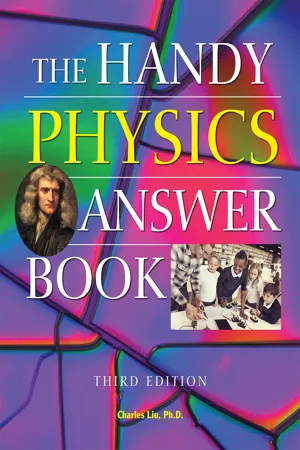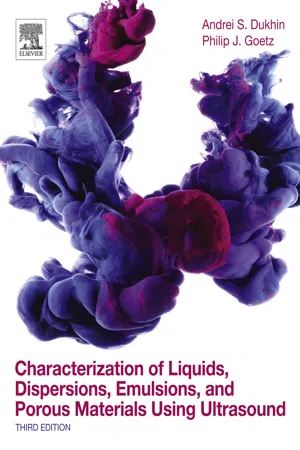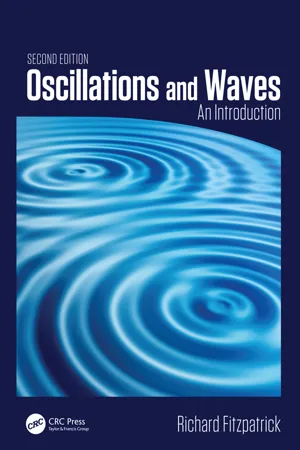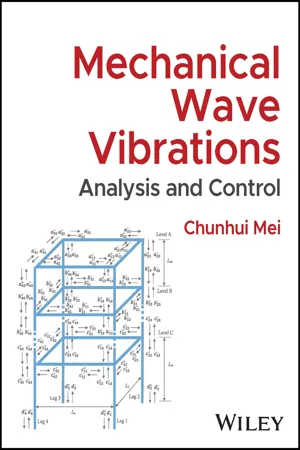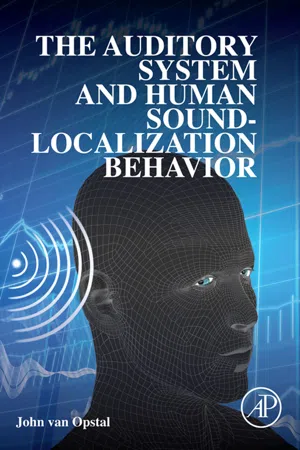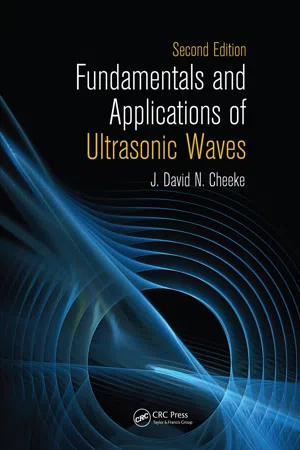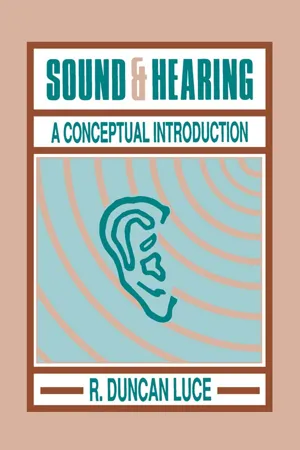Physics
Longitudinal Wave
A longitudinal wave is a type of wave in which the oscillations occur in the same direction as the wave's propagation. This means that the particles of the medium move parallel to the direction of the wave. Sound waves are a common example of longitudinal waves, where the air particles move back and forth in the same direction as the sound wave travels.
Written by Perlego with AI-assistance
Related key terms
Related key terms
1 of 4
Related key terms
1 of 3
10 Key excerpts on "Longitudinal Wave"
- eBook - ePub
- Charles Liu(Author)
- 2020(Publication Date)
- Visible Ink Press(Publisher)
The velocity of a wave depends upon the material or medium in which it is traveling. Typically, the stronger the coupling between the atoms or molecules that make up the medium and the less massive they are, the faster the wave will travel. All waves of the same type (transverse or longitudinal) travel at the same speed through the same medium. For example, a sound wave in air at 0°C will travel at 331 meters per second regardless of the sound’s frequency or amplitude.The velocity of water waves depends both on the properties of the water and on the frequency of the wave.Electromagnetic waves are special transverse waves that can travel either through empty space or through material. Their velocity depends on the electric and magnetic properties of space or the material but not on the frequency or amplitude of the wave.What happens when a Longitudinal Wave travels through a medium?
The medium (for example, air or water) in Longitudinal Waves alternately pushes close together (this is called compression) and separates (this is called rarefaction). One very good example of Longitudinal Waves in a medium are sound waves, which are a series of back-and-forth, longitudinal oscillations of atoms or molecules that form alternate regions of high and low pressure in a medium such as air.What are amplitude, period, frequency, and wavelength?
These are terms used to describe the properties of a wave. A wave’s amplitude is the distance from the midpoint of a wave to the point of maximum displacement (a crest in a transverse wave or the compression of a Longitudinal Wave). The period is the amount of time it takes a wave to complete a full cycle (from crest to trough back to crest, or compression to rarefaction back to compression). The frequency is the number of cycles of the wave that occur in one second. The wavelength of a wave is the distance from crest to crest or from compression to compression. - No longer available |Learn more
MCAT Physics and Math Review 2024-2025
Online + Book
- (Author)
- 2023(Publication Date)
- Kaplan Test Prep(Publisher)
propagation (movement) of the wave. To visualize this, consider “The Wave” in a stadium. While “The Wave” moves around the stadium, individuals in the stands do not run around the stadium themselves. Rather, they move perpendicular to the direction of “The Wave”—by standing up and sitting down. More common examples on the MCAT include electromagnetic waves, such as visible light, microwaves, and X-rays. You could also form a transverse wave by attaching a string to a fixed point, and then moving your hand up and down, as is demonstrated in Figure 7.1a. In any waveform, energy is delivered in the direction of wave travel, so we can say that for a transverse wave, the particles are oscillating perpendicular to the direction of energy transfer.Longitudinal Waves are ones in which the particles of the wave oscillate parallel to the direction of propagation; that is, the wave particles are oscillating in the direction of energy transfer. Sound waves are the classic example of Longitudinal Waves, but because we can’t see sound, this waveform is a little more difficult to picture. Figure 7.1b helps us visualize what a Longitudinal Waveform traveling through air would look like. In this case, the Longitudinal Wave created by the person moving the piston back and forth causes air molecules to oscillate through cycles of compression and rarefaction (decompression) along the direction of motion of the wave. You could also form a Longitudinal Wave by laying a Slinky flat on a table top and tapping it on the end.Figure 7.1. Wave Types(a) Transverse: particles oscillate perpendicular to the direction of propagation; (b) Longitudinal: particles oscillate parallel to the direction of propagation.KEY CONCEPT
Transverse waves have particle oscillation perpendicular to the direction of propagation and energy transfer. Longitudinal Waves have particle oscillation parallel to the direction of propagation and energy transfer.Describing Waves
Waves can be described mathematically or graphically. To do so, we must first assign meaning to the physical quantities that waves represent. The distance from one maximum (crest) of the wave to the next is called the wavelength (λ). The frequency (f) is the number of wavelengths passing a fixed point per second, and is measured in hertz (Hz) or cycles per second (cps). From these two values, one can calculate the propagation speed (ν - eBook - ePub
- Andrei S. Dukhin, Philip J. Goetz(Authors)
- 2017(Publication Date)
- Elsevier(Publisher)
We call traveling compression waves in liquids as “Longitudinal Waves,” while “transverse waves” are typified by a vibrating string. The direction that the material moves in relative to the direction of wave propagation makes all the difference. For a Longitudinal Wave, the liquid molecules move back and forth in the direction of the wave propagation, whereas for a transverse wave this motion is perpendicular to the direction of propagation. Longitudinal Waves, in the most general case, are three dimensional with a potentially very complex geometry. Here we will consider only two dimensional plane waves, which have the same direction of propagation everywhere.Longitudinal Waves can propagate in a fluid because the fluid has a finite compressibility that allows the energy to be transported across the space. In addition to these compression waves, the sound wave may also induce shear and thermal waves at the boundaries with other surfaces. Compression waves are able to propagate long distances in the liquid, whereas shear and thermal waves exist only in the close vicinity of the phase boundaries. This chapter covers only compression Longitudinal Waves. Shear and thermal waves play a major role in colloidal systems because of the extended surface area. This aspect is dealt with in detail in Chapter 4 .We consider the liquid to be in equilibrium having a certain density, ρ m , at a given static pressure, P , and temperature, T . The relationship between these three parameters can be described by two partial derivatives, one at a constant temperature and another at a constant pressure. Together, these equations constitute the so-called “equations of state,” namely:β p=1ρ m(T)∂ρ m∂ P(3.1)β =1ρ m(P)∂ρ m∂ T(3.2)We commonly refer to the coefficient β p as the “isothermal compressibility” and the coefficient β as the “thermal expansion coefficient.”The presence of a sound wave at a particular instant of time, and point in space, causes an incremental variation of the density, pressure, and temperature, i.e., their equilibrium values ρ m , P eq , and T . We designate the instantaneous values of these incremental changes as δρ m , δP , and δT , respectively. The pressure variation is the easiest to detect, and is in fact a typical output of an acoustic experiment. The sound wave pressure is usually expressed in decibels, abbreviated as dB, and defined as 20 times the logarithm to the base 10 of the ratio of the pressure amplitude, in dynes per centimeter square, and a reference level of 1 - eBook - ePub
- Michael M. Mansfield, Colm O'Sullivan(Authors)
- 2020(Publication Date)
- Wiley(Publisher)
Figure 13.2 can represent either phenomenon. As indicated in the figure, the disturbance from equilibrium can be positive or negative.A transverse wave. The disturbance is perpendicular to the direction of the wave velocity.Figure 13.2In a longitudinal wave the disturbance from equilibrium is parallel to the direction of propagation of the waves, the direction of their velocity. Sound waves in air, compression waves as illustrated in Figure 13.3 , are Longitudinal Waves. The compression is caused by the source of the sound (for example, a vibrating membrane such as a vocal chord or a loudspeaker) and is carried as a compression wave; it can be detected when it disturbs another membrane (for example, an ear drum or a microphone). The disturbance and the direction of propagation of compression waves are therefore along the same axis but note that, as with transverse waves, there is no net motion of particles in the transmitting medium. Air molecules return to their equilibrium positions after a sound wave has passed. As might be expected, the transmission of sound waves depends on the elasticity of the air when it is compressed, that is, on its bulk modulus (Section 10.4 ). We shall investigate this dependence in Section 13.13 .Although waves can be transverse or longitudinal, the formalism which we shall develop to describe wave motion may be applied equally well to either type of wave.A Longitudinal Wave. As a sound wave travels through air, the disturbance of the air molecules is parallel to the direction of the wave velocity.Figure 13.3Sinusoidal waves
Initially, we shall find it easier to analyse wave motion by considering a continuing disturbance rather than a single wave pulse. Eventually, in Section 13.15 - eBook - ePub
Oscillations and Waves
An Introduction, Second Edition
- Richard Fitzpatrick(Author)
- 2018(Publication Date)
- CRC Press(Publisher)
CHAPTER 5Longitudinal Standing Waves
5.1 INTRODUCTIONThe aim of this chapter is to generalize the analysis of the previous chapter in order to deal with longitudinal standing waves. A standing wave is a disturbance in a physically continuous mechanical system that is periodic in space as well as in time, but which does not propagate. A Longitudinal Wave is one in which the direction of oscillation is parallel to the direction along which the phase of the waves varies sinusoidally.5.2 SPRING-COUPLED MASSESConsider a mechanical system consisting of a linear array of N identical masses m that are free to slide in one dimension over a frictionless horizontal surface. Suppose that the masses are coupled to their immediate neighbors via identical light springs of unstretched length a, and force constant K. (Here, we employ the symbol K to denote the spring force constant, rather than k, because k is already being used to denote wavenumber.) Let x measure distance along the array (from the left to the right). If the array is in its equilibrium state then the x-coordinate of the ith mass is xi = i a, for i = 1, N. Consider longitudinal oscillations of the masses. Namely, oscillations for which the x-coordinate of the ith mass is(5.1)x i= i a +ψ i( t ) ,where ψi (t) represents longitudinal displacement from equilibrium. It is assumed that all of the displacements are relatively small; that is, |ψi | ≪ a, for i = 1, N.Consider the equation of motion of the ith mass. See Figure 5.1 . The extensions of the springs to the immediate left and right of the mass are ψi − ψi− 1 and ψi +1 − ψi , respectively. Thus, the x-directed forces that these springs exert on the mass are −K (ψi − ψi− 1 ) and K (ψi +1 − ψi ), respectively. The mass’s equation of motion therefore becomes(5.2)=ψ ¨iω 0 2(ψ− 2i − 1ψ i+ψ) ,i + 1where. Because there is nothing special about the ith mass, the preceding equation is assumed to hold for all N masses; that is, for i = 1, N. Equation (5.2)ω 0=K / m - eBook - ePub
Mechanical Wave Vibrations
Analysis and Control
- Chunhui Mei(Author)
- 2023(Publication Date)
- Wiley(Publisher)
2 Longitudinal Waves in BeamsSimilar to the propagation of acoustical waves and electro-magnetic waves through gaseous, liquid, and solid media, mechanical vibrations can be described as waves that propagate in a solid medium (Graff 1975; Cremer et. al. 1987; and Doyle 1989). From the wave standpoint, vibrations in a distributed or continuous structure can be viewed as waves that propagate along uniform waveguides and are reflected and transmitted at structural discontinuities (Mace 1984). The propagation relationships of waves are governed by the equations of motion of a beam for free vibration, and the reflection and transmission relationships are determined by the equilibrium and continuity at a structural discontinuity. Assembling these propagation, reflection, and transmission relationships provides a concise and systematic approach for vibration analysis of a distributed or continuous structure.In this chapter, fundamental concepts related to Longitudinal Waves are introduced, such as the propagation coefficient of longitudinal vibration waves along a uniform beam (the waveguide) and the reflection coefficient of longitudinal vibration waves at either a classical or non-classical boundary (the discontinuity). Natural frequencies, modeshapes, as well as steady state frequency responses, are obtained, with comparison to experimental results. MATLAB scripts for numerical simulations are provided. - John van Opstal(Author)
- 2016(Publication Date)
- Academic Press(Publisher)
Chapter 2The Nature of Sound
Abstract
This chapter summarizes the physical properties of sound waves that will be relevant in the later chapters. A simple elastic gas model can explain how the propagation speed of sound depends only on the bulk modulus and density of the air. We then introduce the homogeneous linear wave equation, from which the superposition of harmonic solutions (standing waves and traveling waves), and the concept of Fourier series are derived. As an example, we discuss the fundamental problem of spectral–temporal resolution. We then describe how inhomogeneities in the medium may change the wave equation and lead to nonharmonic spatial waves. We introduce the concept of acoustic impedance, and how this defines the conditions for transmission and reflection at boundaries between different media. We illustrate these ideas for the middle-ear transfer of acoustic energy from air to the fluid-filled cochlea. Finally, we discuss how the dispersion relation for homogeneous and inhomogeneous media relates to the phase and group velocities of the acoustic signals.Keywords
speed of sound acoustic impedance wave equation superposition Fourier series binaural beats transmission reflection decibel dispersion relation phase velocity group velocity2.1. Longitudinal pressure waves in a medium
Sound is a pressure perturbation in a medium like air or water, which is caused by a vibratory source that oscillates in the 50–20,000 Hz range (Serway and Jewett, 2013 ). The perturbation propagates as a longitudinal traveling wave through the medium, in which the molecular movements associated with the perturbation are along the same direction as the propagating traveling wave. Think of a vibrating membrane (a loudspeaker) at position x = 0, moving inward and outward in the x -direction at frequency f 0 Hz. When the membrane moves, it pushes or drags the air molecules at x = 0 in the same direction, thereby creating a local increase or decrease in the density of air molecules, which consequently increases or decreases the local pressure. These pressure changes propagate in the x -direction through the medium. The wave is thus described by a succession of compressions (regions of high pressure, c ) and rarefactions (regions of low pressure, r ), which propagate through the medium at velocity v sound . In air, at sea level at a temperature of 20°C, and at a mean pressure of 105 N/m2 (1 atm), the speed of sound is approximately v sound- eBook - ePub
Guided Waves in Structures for SHM
The Time - domain Spectral Element Method
- Wieslaw Ostachowicz, Pawel Kudela, Marek Krawczuk, Arkadiusz Zak(Authors)
- 2011(Publication Date)
- Wiley(Publisher)
Bounding the elastic medium with two equidistant surfaces causes compressional waves and shear waves to interact, which results in the generation of Lamb waves. One can say that a free boundary restricting an elastic body guides and drives waves; therefore the term guided waves is also used. Lamb waves and guided waves are used in broadly considered diagnostics and nondestructive testing. There are also waves that propagate on media boundary (interface waves) with names derived from their discoverers: in the interface between two solids Stoneley waves propagate, while in the one between a solid and a liquid Scholte waves propagate. Figure 1.1 Distribution of displacements for the horizontal shear wave 1.1.1 Longitudinal Waves (Compressional/Pressure/ Primary/P Waves) Longitudinal Waves are characterised by particle motion alternately of compression and stretching character. The direction of medium point motion is parallel to the direction of wave propagation (i.e. longitudinal). 1.1.2 Shear Waves (Transverse/Secondary/S Waves) Shear waves are characterised by transverse particle movements in alternating direction. The direction of medium particle motion is perpendicular to the propagation direction (transverse). The transverse particle movement can occur horizontally (horizontal shear wave, SH; see Figure 1.1) or vertically (vertical shear wave, SV; see Figure 1.2). Figure 1.2 Distribution of displacements for the vertical shear wave 1.1.3 Rayleigh Waves Rayleigh waves (Figure 1.3) are characterised by particle motion composed of elliptical movements in the xy vertical plane and of motion parallel to the direction of propagation (along the x axis). Wave amplitude decreases with depth y, starting from the wave crest. Rayleigh waves propagate along surfaces of elastic bodies of thickness many times exceeding the wave height - J. David N. Cheeke(Author)
- 2017(Publication Date)
- CRC Press(Publisher)
z direction.The energy and acoustic power relations for both longitudinal and transverse waves can be extended directly from their 1D forms. Thus, the potential and kinetic energies per unit volume areandu P=Ti jdSi jd t ( 5.31 )u K=1 2ρu i* 2 ( 5.32 )The instantaneous Poynting vector P , which gave a power flow −vT per unit area in one dimension, becomes straightforwardlyin three dimensions.P j(= -x i, t )Ti j∂u i∂ t ( 5.33 )The above analysis shows that bulk waves consist of one longitudinal mode and two mutually orthogonal transverse modes. A standard terminology has been developed to identify these modes, and it is used universally to describe bulk and guided modes. The plane of the paper (saggital plane) contains the x axis and the surface normal (z axis). The y axis is perpendicular to this plane. Calculations for bulk modes will then be carried out with Longitudinal Waves and transverse waves with polarization in the plane of the paper both having wave vectors in the plane of the paper. These may also be referred to as pressure (P) and shear vertical (SV) modes, respectively, following the original geophysical terminology. Transverse waves propagating in the saggital plane with polarization perpendicular to the paper (y axis) are called shear horizontal (SH) modes. In this language, the acoustic modes conveniently break up into the orthogonal, uncoupled groups of saggital (P, SV) and SH modes.5.3 Material Properties
We discuss first the propagation properties primarily associated with the sound velocity. This is followed by a summary of the principal sources of attenuation of ultrasonic waves. It is important to have a feeling for the orders of magnitude of the densities, sound velocities, and acoustic impedances of different materials. Representative values are given in Table 5.1 , which should be compared with those of Table 3.1 . A cursory glance confirms what we already know, namely that most solids have densities and sound velocities much greater than water, which are again much greater than those in air. This state of affairs is most usefully summarized in a single parameter, the acoustic impedance, given for longitudinal and transverse waves in Figures 5.2 and 5.3 . It will be shown in Chapter 7- eBook - ePub
Sound & Hearing
A Conceptual Introduction
- R. Duncan Luce(Author)
- 2013(Publication Date)
- Psychology Press(Publisher)
II.2. Once again, move your hand briskly, but this time in the same direction as the slinky, toward the wall, as in panel b. Again, reverse direction and then immediately return your hand to the original position, as in panel c. Now, watch as the pulse propagates along the slinky. The pulse is noticeable because it involves a narrow region in which the spring is more tightly coiled than normal, called a condensation, followed by a narrow region in which it is less tightly coiled than normal, called a rarefaction (see panel d). FIG. II.2 Generating a longitudinal pulse on a spring, such as a slinky, by rapid movements of the unconstrained end in the overall direction of the spring, first toward and then away from the constrained end. A pulse of this character is called longitudinal because the changes are all in the direction of the propagation. Observe that on the slinky one can produce either a longitudinal or a transverse pulse depending on whether the hand is moved in a longitudinal or a transverse manner. Also, note that the speed of propagation of the two types of pulses differs, with the longitudinal faster than the transverse pulse; this is typical. 1.3 Propagation in a “Continuous” Medium A continuous medium is either a gas, such as air; a liquid, such as water; or a more-or-less homogeneous solid, such as metal, stone, or wood. Any of these propagate sound pulses. Recall that in reality none of these media are really continuous, but rather are composed of many small molecules. We may idealize them as tiny billiard balls floating about in space. In a gas, the molecules are relatively independent of each other, moving around with an average velocity that depends on the temperature, and they continually collide with each other, thereby changing direction of movement irregularly. Those collisions are the source of pressure in the gas
Index pages curate the most relevant extracts from our library of academic textbooks. They’ve been created using an in-house natural language model (NLM), each adding context and meaning to key research topics.
Explore more topic indexes
Explore more topic indexes
1 of 6
Explore more topic indexes
1 of 4
